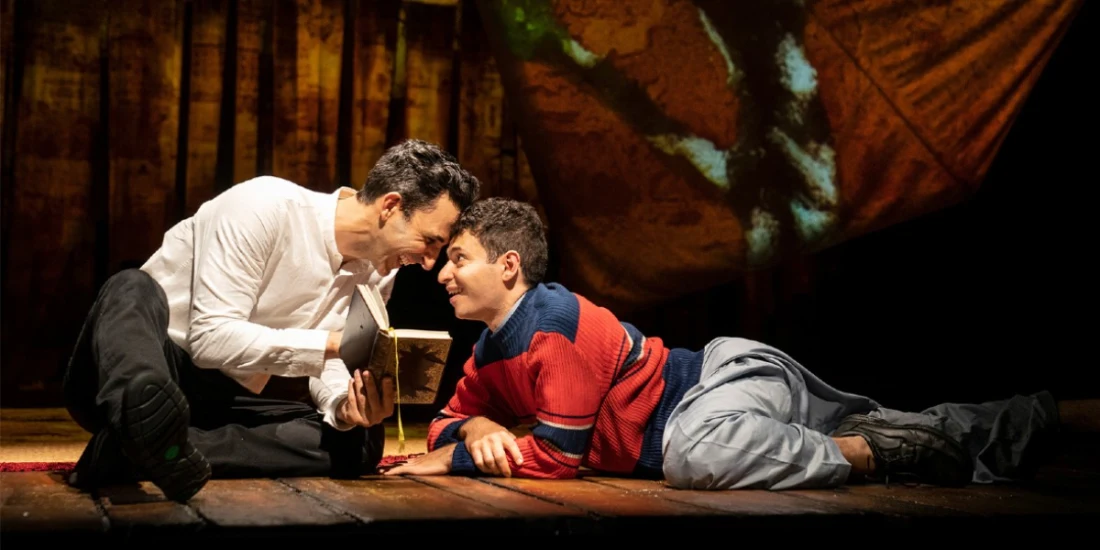'The Kite Runner' review — stage adaptation of bestselling book is faithful to a fault
In The Kite Runner, kite flying factors in two pivotal scenes. In the first, the actors come out waving gauzy white fabric hanging from springy wire rods, giving the illusion of kites flying in the air. At my performance, one of the kites failed to sufficiently lift off above the actor's head. It hovered slightly, then dipped toward the ground. The actor valiantly tried to pull it up, but the kite refused to take flight, seemingly comfortable bobbing along at shoulder height. This can be a metaphor for the play, which tries to soar beyond its origins as a novel, but remains steadfastly bound by its source material.
The Kite Runner is based on Khaled Hosseini's bestselling 2003 novel of the same name. It is set in Afghanistan and is about two friends, Amir (Amir Arison) and Hassan (Eric Sirakian). The two are born only a year apart but have vastly different lives: Amir is rich and educated, Hassan is poor and illiterate; Amir is the master, Hassan is the servant; Amir is Pashtun, the dominant ethnic group in Afghanistan, while Hassan is Hazara, the minority group. Despite their differences, the two are best friends. But when Hassan is raped by a group of Pashtun boys, Amir chooses to runs away instead of helping his friend. That guilt, and his eventual redemption, makes up the bulk of the play and the novel.
In adapting the story, Matthew Spangler turns The Kite Runner into a memory play: Amir as an adult tells his story to us, the audience, as a flashback. Director Giles Croft (who has directed The Kite Runner in London) has Arison play Amir as a boy and an adult, which means Arison never leaves the stage throughout the play's 2.5-hour running time. Fortunately, Arison is magnetic as Amir, his lanky frame and everyman energy making him an inherently sympathetic narrator (even when Amir does the unforgivable). Arison's voice is deep and rich; you hang onto his every word.
In a novel, you need such a narrator to help you visualize a story from start to finish. The theatre has additional tools: actors, sets, music. Not everything in a play needs to be verbally described to the audience. But instead of utilizing those stage elements, Spangler and Croft overly rely on Hosseini's words. The play doesn't give The Kite Runner new dimensions, as an adaptation should. Instead, it feels like a CliffsNotes version of the novel.
The play tells the audience what is happening instead of showing it. In a pivotal kite flying scene, there are no kites onstage. Instead, Arison stands in a kite-flying stance, snapping his body back and forth while describing what is happening. In the background, the ensemble provides swooshing sound effects. By not letting the audience see the kite competition, the narration robs the scene of dramatic tension and an opportunity for dynamic visual storytelling. Instead of being shown the splendor of dozens of kites in the air, battling for dominance, we're told about it. It's a missed opportunity when the only real kite in the play is being sold in the gift shop.
Adaptations can also improve upon the source material. In the original novel, Hassan is less of a fully developed human than a sacrificial lamb that needs to be slaughtered for Amir's personal development. Sirakian, with his round face and bright eyes, is heartbreaking as the innocent Hassan. But he is not given much to do beyond being uncomplicatedly good. Any potential dimension has been cut away. In The Kite Runner novel, after Hassan is raped, Amir describes not seeing him for a week, with Hassan's father, Ali, saying, "Lately, it seems all he wants to do is sleep. He does his chores, but then he just wants to crawl under his blanket." The play cuts that line during an exchange between Ali (Evan Zes) and Amir. So even when Hassan is in pain, that pain is not given space to breathe, and the audience is not invited to sit with that loss of innocence. Instead the stage is immediately filled with more words, more narration, more plot.
Compared with the surfeit of words, The Kite Runner has a very sparse set: A cityscape backdrop, some hanging curtains for projections, and sloped walkways on either side of the stage that make it look like the play takes place in a skate park instead of Afghanistan. Musician Sala Nader is onstage the entire time, playing the tabla — the sound is the most effective element, giving The Kite Runner a sense of place.
It is a testament to Hosseini's writing that the story is still compelling, and freshly relevant after America's shameful departure from Afghanistan. The production also manages to find humor in Hosseini's prose. When Arison says, "Hassan's mother suffered a fate most Afghans consider far worse than death," he gives a well-placed pause before saying, "She ran off with a troupe of actors and musicians."
Toward the end of the play, Amir kneels down in prayer, his arms out and hands outstretched, repeating in Arabic: "There is no God but Allah and Muhammad is his messenger." The stage is dark aside from a single spotlight. In that moment, The Kite Runner is given the rare chance to be still. So much is unspoken in Arison's inflections and body language: his desperation, sadness, and guilt. The moment is haunting in its simplicity. If only The Kite Runner on Broadway depended less on the novel and trusted more on its stagecraft. There might have been more moments like this, of flight and transcendence.
Photo credit: Amir Arison and Eric Sirakian in The Kite Runner. (Photo by Joan Marcus)
Originally published on
